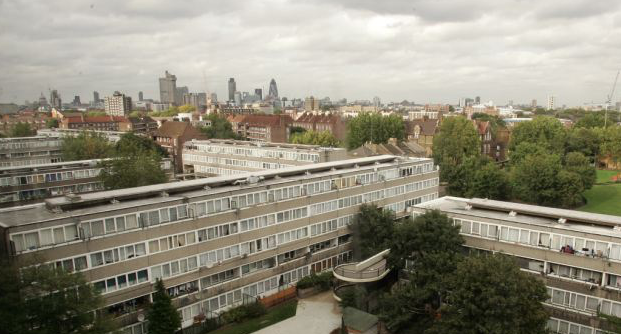Post
REPORT | Saturday Planning School 2 – Social/Affordable Housing
3 Nov 2017
The second in our series of 'Planning School' talks was held on 28 October at the Building Centre in Store Street (in association with the Building Environment Trust), with Dr Paul Watt of Birkbeck talking about Social/Affordable Housing in London. Ian R Morrison was in the audience.
A fascinating talk on social housing in London with research that Dr Watt has been doing on estates, illustrated with slides and statistics.
Social housing is allocated on the basis of need, rather than demand and price (market forces). Its alternatives are the private rented sector and owner occupation. Provision varies between countries. At around 20%, the UK is higher than in the U.S., but not as high as other countries in Europe. Its prevalence is determined by political choices, for example social democrat traditions in parts of Europe.
Affordable housing is promoted to help solve the ‘housing crisis’, particularly in London. But affordable can take a number of forms, from being based on local incomes to being tied to a percentage of market rent. But how affordable is affordable? A limit of 80% of market rent in East Village Stratford (the Olympics site) is still out of reach of many local people. The Mayor’s new strategy of ‘genuinely affordable’ will aim to address this.
In the late 19th century 90% of housing in London was private rental, often overcrowded and in poor condition. Two developments introduced reform: philanthropy (e.g. Guinness) and local authority housing (Housing of the Working Classes Act 1890) – the Boundary Estate in Shoreditch is an early example, still standing today. Local government became a provider. The boom in London was from 1945 to 1961. With Labour majorities in inner London boroughs, social housing grew to almost 70% in some parts. This contrasted with Paris, where political groupings led to social housing being predominantly in ‘les banlieus’.
1961 to 2011 saw changes, with owner occupation increasing, and private rental at first decreasing but beginning to come back to what are now high levels (these could reach 40% by 2027). Local authority housing had fallen from 30% in 1961 to 13% in 2011, but with almost 440,000 tenants in London was still a significant contribution. The reduction was caused by cuts in LA building from 1980, ‘right to buy’, regeneration schemes and ‘stock transfer’ mainly to housing associations. This has had four effects: a crisis in housing; increase in temporary accommodation; increase in the private rented sector; and gentrification.
Regeneration has a number of drivers, including architectural/aesthetic, social and economic. Its starting point is often the notion of the ‘failed estate’. But its effects include smaller increases in affordable rents and the loss of social housing.
Paul has done research with residents – for example, at Churchill Gardens and West Hendon. Residents are not anti-regeneration per se but do resent their portrayal as ‘sink estates’, find the aims of regeneration ‘fuzzy’, and complain about inadequate consultation. The schemes often overlook the human factor and the effects on residents’ health. They tend to take years to complete (10-15) and while producing more new homes (though of impersonal design) the process can too often be one of insecurity and loss of community for residents. Exhaustion can set in! This has led to some campaigns against regeneration (accusations of state-led gentrification or ‘social cleansing’). Jeremy Corbyn is starting to challenge the approach of some London Labour councils on this.
